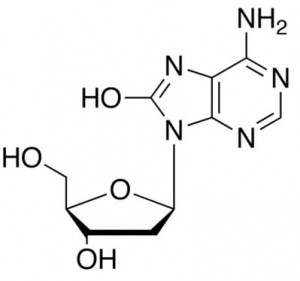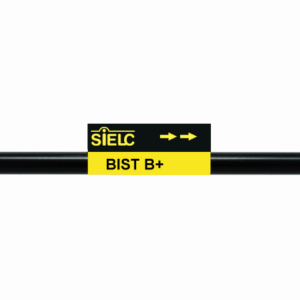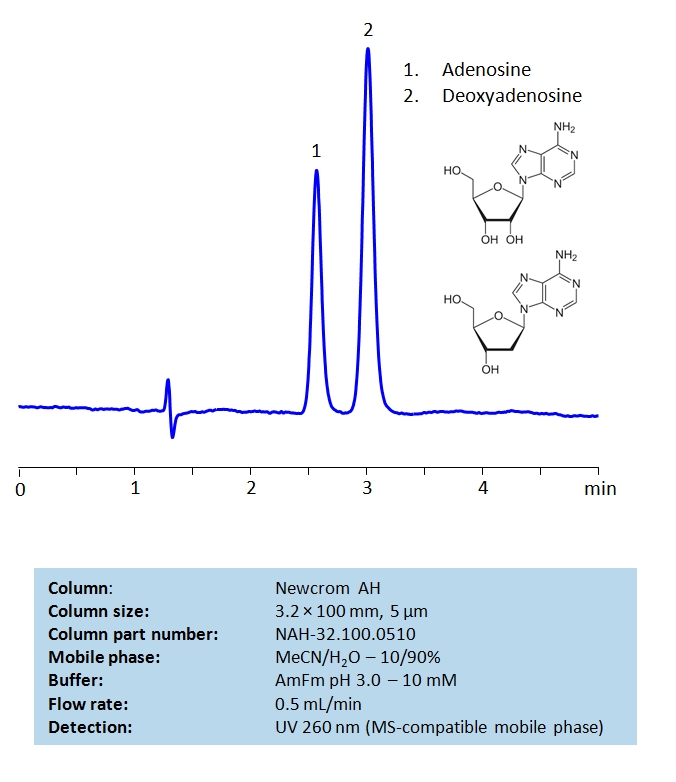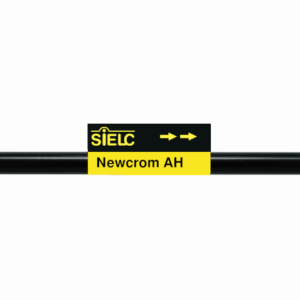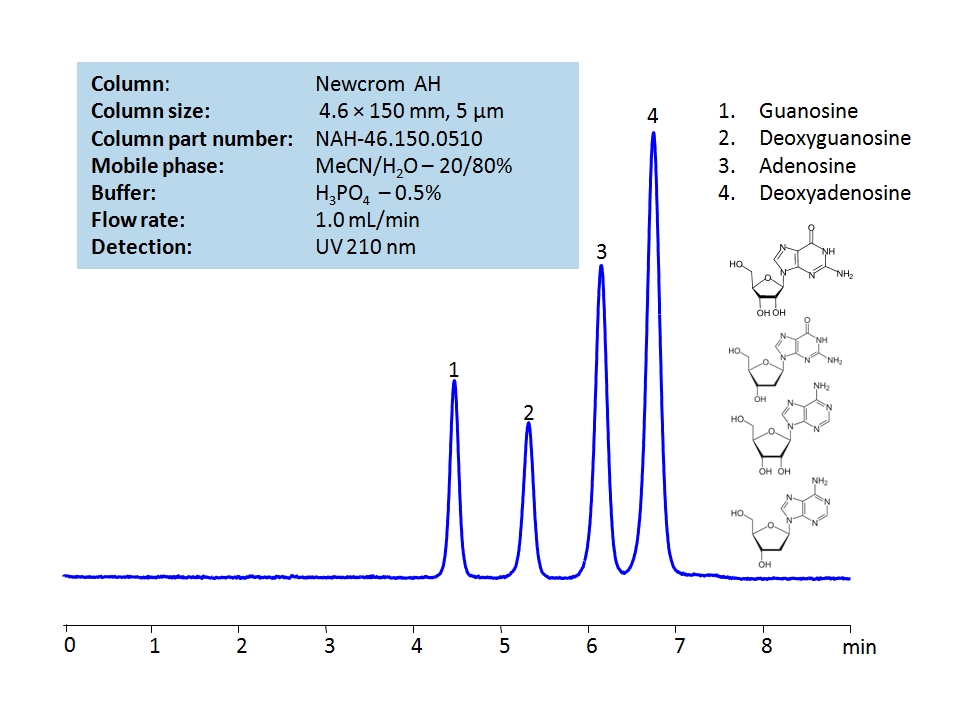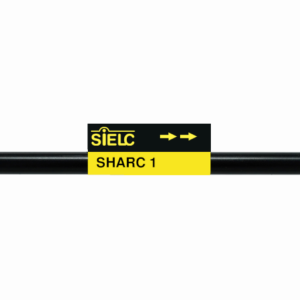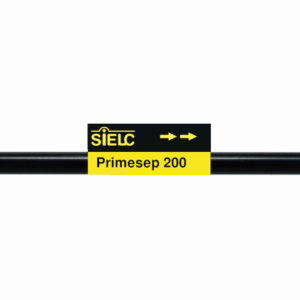| CAS Number | 40627-14-3 |
|---|---|
| Molecular Formula | C10H13N5O3 |
| Molecular Weight | 251.246 |
| InChI Key | OLXZPDWKRNYJJZ-RRKCRQDMSA-N |
| LogP | -0.5 |
| Synonyms |
|
Applications:
HPLC Method for Analysis of 3′-Deoxyadenosine and 2′-Deoxyadenosine on BIST B+ Column
December 1, 2022
HPLC Method for Cordycepin, Deoxyadenosine on BIST B+ by SIELC Technologies

Cordycepin is an adenosine analogue with the chemical formula C10H13N5O3. It is reported to prevent cell reproduction in various cancer cells. It also might possess antioxidant and anti-inflammatory properties, when considered in addition with it’s ability to cross the blood-brain barrier, it may become widely used in pharmaceuticals.
Deoxyadenosine is a deoxyribonucleoside with the chemical formula C10H13N5O3. It is a derivative of adenosine. High presence of it can kill T lymphocytes and kill those cells, leading to adenosine deaminase severe combined immunodeficiency disease, also known as ADA-SCID.
Cordycepin, Deoxyadenosine can be retained and analyzed using the BIST B+ stationary phase column. The analysis utilizes an isocratic method with a simple mobile phase consisting of water and acetonitrile (MeCN) with a Phosphoric Acid buffer. Detection is performed using UV.
Condition
| Column | BIST B+, 4.6 x 150 mm, 5 µm, 100 A, dual ended |
| Mobile Phase | MeCN – 85% |
| Buffer | H3PO4 – 0.2% |
| Flow Rate | 1.0 ml/min |
| Detection | UV 260 nm |
| Peak Retention Time | 8.2, 9.8 min |
Description
| Class of Compounds | Nucleosides |
| Analyzing Compounds | Cordycepin, Deoxyadenosine |
Application Column
BIST B+
Column Diameter: 4.6 mm
Column Length: 150 mm
Particle Size: 5 µm
Pore Size: 100 A
Column options: dual ended
Deoxyadenosine

HPLC Method for Separation of Adenine, Deoxyadenosine and Adenosine on BIST B+ Column
November 28, 2022
HPLC Method for Separation of Adenine, Deoxyadenosine, Adenosine on BIST B+ by SIELC Technologies.
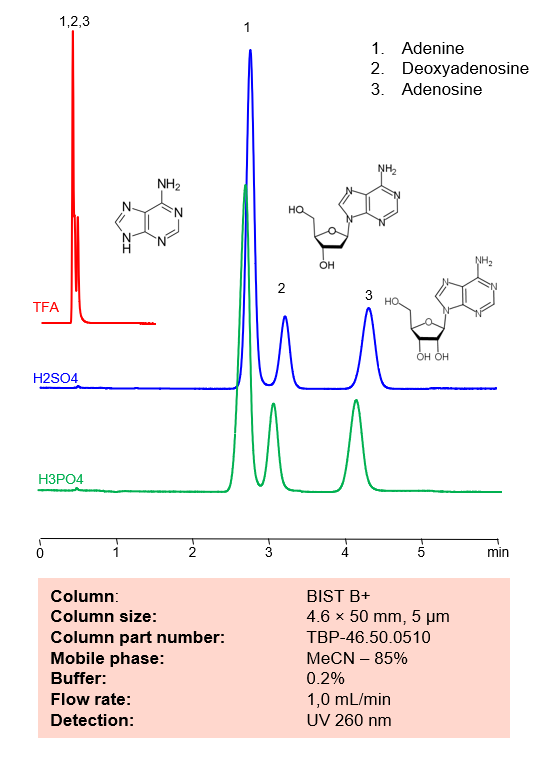
Adenine, also noted as A and Ade, has the chemical formula C5H5N5. Besides DNA and RNA, Adenine can also be found in Adenosine triphosphate (ATP), which is a nucleotide triphosphate that provides energy in cells required for bodily functions. In DNA, it partners with Thymine via two hydrogen bonds, while in RNA it bonds to Uracil for protein synthesis.
Deoxyadenosine is a deoxyribonucleoside with the chemical formula C10H13N5O3. It is a derivative of adenosine. High presence of it can kill T lymphocytes and kill those cells, leading to adenosine deaminase severe combined immunodeficiency disease, also known as ADA-SCID.
Adenosine is a key building block of energy-carrying molecules with the chemical formula C10H13N5O4. It has a variety of other uses, including being a inhibitory neurotransmitter which helps with sleep and acting as a blood flow regulator. Medicinally, it is used as treatment for supraventricular tachycardia (SVT). You can find detailed UV spectra of Adenosine and information about its various lambda maxima by visiting the following link.
Adenine, Deoxyadenosine, Adenosine can be retained and analyzed using the BIST B+ stationary phase column. The analysis utilizes an isocratic method with a simple mobile phase consisting of water and acetonitrile (MeCN) with a sulfuric acid buffer. Detection is performed using UV.
Condition
| Column | BIST B+, 4.6 x 50 mm, 5 µm, 100 A, dual ended |
| Mobile Phase | MeCN – 85% |
| Buffer | H2SO4 – 0.2% |
| Flow Rate | 1.0 ml/min |
| Detection | UV 260 nm |
| Peak Retention Time | 2.8, 3.2, 4.3 min |
Description
| Class of Compounds | Nucleosides |
| Analyzing Compounds | Adenine, Deoxyadenosine, Adenosine |
Application Column
BIST B+
Column Diameter: 4.6 mm
Column Length: 50 mm
Particle Size: 5 µm
Pore Size: 100 A
Column options: dual ended
Adenosine
Deoxyadenosine

HPLC Separation of Adenosine and Deoxyadenosine on Newcrom AH Column
May 26, 2021
HPLC Method for Deoxyadenosine, Adenosine on Newcrom AH by SIELC Technologies
High Performance Liquid Chromatography (HPLC) Method of Adenosine and Deoxyadenosine.
Adenosine is a key building block of energy-carrying molecules with the chemical formula C10H13N5O4. It has a variety of other uses, including being a inhibitory neurotransmitter which helps with sleep and acting as a blood flow regulator. Medicinally, it is used as treatment for supraventricular tachycardia (SVT). You can find detailed UV spectra of Adenosine and information about its various lambda maxima by visiting the following link.
Deoxyadenosine is a deoxyribonucleoside with the chemical formula C10H13N5O3. It is a derivative of adenosine. High presence of it can kill T lymphocytes and kill those cells, leading to adenosine deaminase severe combined immunodeficiency disease, also known as ADA-SCID.
Deoxyadenosine, Adenosine are the building blocks for DNA and RNA as well as other roles in biomechanical processes such as signal transduction. By using a Newcrom AH mixed-mode column with a cation-exchange mechanism, nucleosides: adenosine and deoxyadenosine, can be baseline separated in a short time using an isocratic method with a simple mobile phase of water, acetonitrile (MeCN, ACN), and ammonium formate (AmFm) buffer. Detection can be achieved with UV 260 nm, mass spectrometry (MS), evaporative light scattering detection (ELSD) and Charged aerosol detection (CAD).
| Column | Newcrom AH, 3.2 x 100 mm, 5 µm, 100 A, dual ended |
| Mobile Phase | MeCN/H2O – 10/90% |
| Buffer | AmFm pH 3.0 – 10 mM |
| Flow Rate | 1.0 ml/min |
| Detection | UV, 260 nm |
| Class of Compounds |
Nucleatide |
| Analyzing Compounds | Deoxyadenosine, Adenosine |
Application Column
Newcrom AH
Column Diameter: 3.2 mm
Column Length: 100 mm
Particle Size: 5 µm
Pore Size: 100 A
Column options: dual ended
Deoxyadenosine

HPLC Separation of Guanosine, Deoxyguanosine, Adenosine, Deoxyadenosine on Newcrom AH Column
May 25, 2021
HPLC Method for Adenosine, Guanosine, Deoxyguanosine, Deoxyadenosine on Newcrom AH by SIELC Technologies
High Performance Liquid Chromatography (HPLC) Method for Analysis of Adenosine, Guanosine, Deoxyguanosine, Deoxyadenosine.
Guanosine is a purine nucleoside with the chemical formula C10H13N5O5. It can be phosphorylated into many other forms, which play vital roles in biochemical possesses like synthesis of nucleic acids, proteins, photosynthesis, and more. It is also required for RNA splicing.
Deoxyguanosine is a deoxyribonucleoside with the chemical formula C10H13N5O4. It is a vital part of what makes up DNA.
Adenosine is a key building block of energy-carrying molecules with the chemical formula C10H13N5O4. It has a variety of other uses, including being a inhibitory neurotransmitter which helps with sleep and acting as a blood flow regulator. Medicinally, it is used as treatment for supraventricular tachycardia (SVT). You can find detailed UV spectra of Adenosine and information about its various lambda maxima by visiting the following link.
Deoxyadenosine is a deoxyribonucleoside with the chemical formula C10H13N5O3. It is a derivative of adenosine. High presence of it can kill T lymphocytes and kill those cells, leading to adenosine deaminase severe combined immunodeficiency disease, also known as ADA-SCID.
Adenosine, Guanosine, Deoxyguanosine, Deoxyadenosine are the building blocks for DNA and RNA as well as other roles in biomechanical processes such as signal transduction. By using a Newcrom AH mixed-mode column with a cation-exchange mechanism, nucleosides: guanosine, deoxyguanosine, adenosine, and deoxyadenosine, can be baseline separated in a short time using an isocratic method with a simple mobile phase of water, acetonitrile (MeCN, ACN), and H3PO4 as a buffer. UV detection at 210 nm.
| Column | Newcrom AH, 4.6 x 150 mm, 5 µm, 100 A, dual ended |
| Mobile Phase | MeCN/H2O – 20/80% |
| Buffer | H3PO4 – 0.5% |
| Flow Rate | 1.0 ml/min |
| Detection | UV, 210 nm |
| Class of Compounds |
Nucleoside, Hydrophilic, Ionizable |
| Analyzing Compounds | Adenosine, Guanosine, Deoxyguanosine, Deoxyadenosine |
Application Column
Newcrom AH
Column Diameter: 4.6 mm
Column Length: 150 mm
Particle Size: 5 µm
Pore Size: 100 A
Column options: dual ended
Deoxyadenosine
Deoxyguanosine
Guanosine

HPLC Separation of Nucleosides and Deoxynucleosides
July 23, 2012
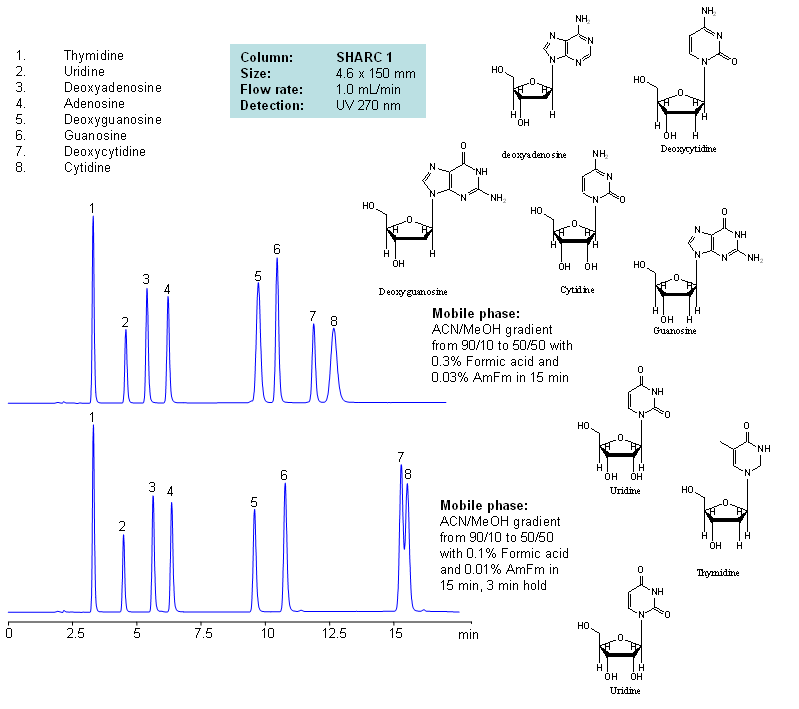
| Column | Sharc 1, 4.6×150 mm, 5 µm, 100A |
| Mobile Phase | MeCN/MeOH |
| Buffer | AmFm, Formic acid |
| Flow Rate | 1.0 ml/min |
| Detection | UV, 270 nm |
| Class of Compounds |
Drug, Acid, Hydrophilic, Ionizable, Vitamin, Supplements |
| Analyzing Compounds | Thymidine, Uridine, Deoxyadenosine, Adenosine, Deoxyguanosine, Guanosine, Deoxycytidine, Cytidine |
Application Column
SHARC 1
The SHARC™ family of innovative columns represents the first commercially available columns primarily utilizing separation based on hydrogen bonding. SHARC stands for Specific Hydrogen-bond Adsorption Resolution Column. Hydrogen bonding involves an interaction or attraction between a bound hydrogen atom and molecules containing electronegative atoms, such as oxygen, nitrogen, and fluorine.
Select optionsCytidine
Deoxyadenosine
Deoxycytidine
Deoxyguanosine
Guanosine
Thymidine
Uridine

Separation of Deoxyribo Nucleosides
September 24, 2003
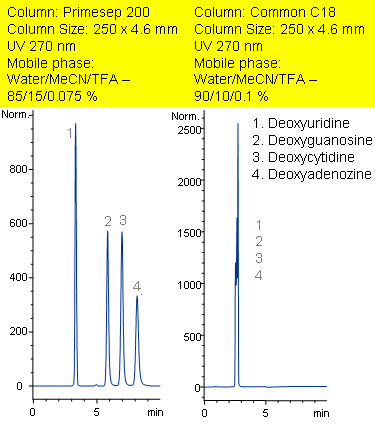
Primesep 200 separates with baseline resolution the nucleosides (deoxyuridine, deoxyguanosine, deoxycytidine, deoxyadenozine) by a combination of cation exchange and reversed phase. These compounds are not retained on a traditional C18 column. Primesep 200 has an embedded anionic functional group which helps retain polar compounds by polar and ion-exchange mechanisms. Excellent peak shape results with a mass spec compatible mobile phase of water, acetonitrile (MeCN, ACN) and trifluoracetic acid (TFA) with UV detection at 270 nm.
Application Column
Primesep 200
Column Diameter: 4.6 mm
Column Length: 250 mm
Particle Size: 5 µm
Pore Size: 100 A
Column options: dual ended
Deoxycytidine
Deoxyguanosine
Deoxyuridine

